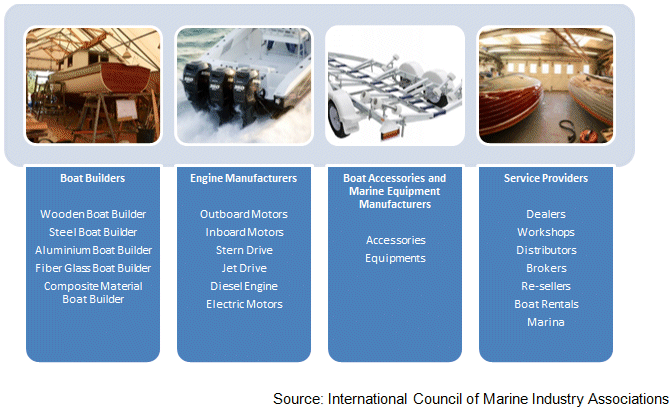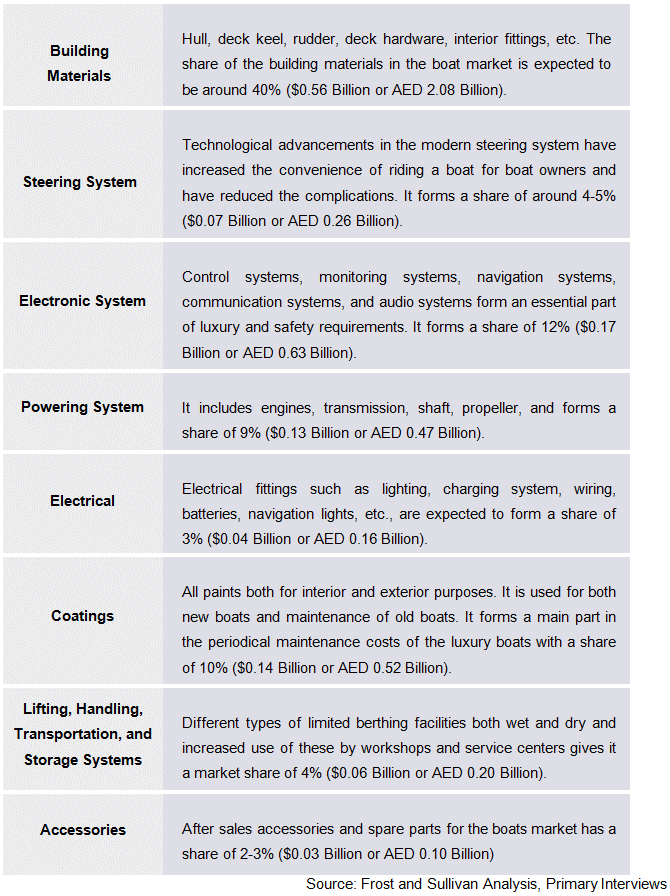The recent oil price collapse was seen as a wake-up call for Gulf States, urging them to look beyond oil and to diversify their economies. GCC economies are moving towards non-oil sector development, which will account for more than 80% of GDP in UAE and KSA.
The region has emerged as a major hub for leisure boating and is a thriving market for yachts and boats. This region accounts for 12% of the world’s superyachts , which denotes that consumers in the region have a high propensity to buy. Marine infrastructure development and evolution of tourism are expected to open up new opportunities in the boat market. The major countries in the GCC boat market are Kuwait, Bahrain, UAE, Oman, and Qatar.
Figure 1 below is a detailed segmentation of the boat market in the UAE/GCC in line with the segmentation by the International rine Industry Associations.
Figure 1: Structure of the Boat Market in the UAE/GCC, 2018

Market Dynamics (Market Size Estimates)
The global recreational boat market is expected to be worth approximately $23 Billion in 2018 and is expected to reach $28-30 Billion by 2022 . The marine industry in the UAE is a well-developed industry and is expected to be worth approximately $66 Billion in 2018 .
However, the recreational boat industry is expected to be worth approximately $1.3-1.5 Billion (AED 4.8-5.5 Billion) in 2018 . It is an emerging market with high spending power and is expected to provide significant opportunities for investors.
In 2016, the UAE imported ships, boats, and floating structures worth $951.5 Million, while it only exported for $447.5 Million, which mainly included re-exports to other GCC countries and other parts of the world .
Table 1 below provides detailed information of the various component groups in the boat market and also gives their market share.
Table 1: Market share of the Component groups in the UAE/GCC Boat Market, 2018
Figure 2 below represents the supply chain of the boat market in the UAE.
Figure 2: Supply Chain of the Boat Market in the UAE, 2018
In the UAE/GCC, only a few marine equipment are manufactured locally. The UAE/ GCC are largely an import-dependent market and almost 88% of the components are imported. Most of the identified key component groups are imported from various countries such as the US, France, Italy, Netherlands, Germany, etc.
Large boat builders directly import marine equipment from the manufacturers, while other boat builders, shipyards, boat workshops, and boat owners import through designated dealers or distributors.
Drivers
Dubai Industrial Strategy 2030 Aims to develop Dubai as a global platform and destination choice for international companies seeking growth and sustainability. Maritime is one of the six target subsectors. The strategy will aim to capitalize on promising opportunities through the localization of manufacturing capabilities in certain maritime sub-industries. It is expected that Dubai will expand its boats and yachts manufacturing activities to meet the domestic demand.
Dubai Maritime City (DMC) is a cluster dedicated to the maritime sector in Dubai that supports the development of maritime industry in Dubai and the GCC. It is also the world’s first dedicated free zone built for the maritime industry. The facilities include yacht manufacturing, ship repair, marine engineering, technological expertise providers, office spaces, and other residential and leisure facilities for the marine community.
Dubai Canal opened in November 2016 and is expected to increase the number of people using marine transport services. It is essentially changing the landscape of boating in the UAE by creating a waterway in the centre of new communities.
Waterfront development of residential properties is also expected to increase the demand for private boats and yachts. Water homes are a considerable turnkey project for Dubai Properties. The project is part of the firm’s ambitions to introduce real estate innovation with centuries of ship building heritage that will transform waterfront living in the Emirates.
Restraints
Volatility in oil prices has significantly affected the GCC economies, which are largely dependent on revenues from oil to finance the Government spending. The fall in prices have affected the Government budgets, which has resulted in delays or stalling of infrastructure developments.
Qatar-Gulf crisis is expected to result in a marginal decline in Qatar’s GDP growth as the crisis will have a negative impact on its economy. Qatar is expected to experience inflation, decline in volume of exports, increase in borrowing costs, and a fall in foreign investments.
Global Economic Slowdown has affected the spending of rich individuals around the world. Russians were big spenders in the GCC leisure market, but post the oil price decline that led to a downturn in the Russian economy there is a reduced spending from them in the GCC.
Need for Standard Regulations for manufacture of boats in the GCC: There are no set boat manufacturing standards followed in the GCC, which has hampered the growth of the market.
VAT Implementation: The UAE and Saudi Arabia have implemented a VAT of 5%. This is expected to increase manufacturing cost of boats, which are already high priced, thereby affecting the demand in the region.
Challenges
High costs involved in boat/yacht maintenance can be daunting. A super yacht will require about 10 per cent of its purchase price to keep it running for just one year (Approximately AED 90 million for a large yacht).
Lack of adequate berthing facilities across the GCC: Most of the GCC residents are sea people and invest on boats or yachts for leisure. However, there are not adequate berthing facilities or marinas for the boats/yachts. Due to lack of facilities, customers hesitate to buy boats.
Shortage of Repair and Maintenance facilities in the GCC/UAE: Top luxury boats/yachts require repair and servicing from top professionals or companies that have an understanding of modern technology. Due to the shortage of facilities and import dependence of the market, boat owners are expected to spend on importing spare parts and services.
Conclusion
The UAE/GCC is a thriving market for leisure boats and yachts driven by marine tourism, increasing water-based sports activities, and coastline property developments. The GCC region has the highest share for the number of yachts owned globally, which is mainly due to the presence of large number of High Net Worth Individuals (HNWI).
Various development projects such as the Dubai Canal and Dubai Harbour are expected to place Dubai in the spotlight of the global leisure boat industry. Gulf Craft is the major player in the region.
[[1] Dubai International Boat Show Brochure 2018
[2] Dubai International Boat Show Brochure 2018, Frost and Sullivan Analysis
[3]“Maritime industry in Dubai on pace to be worth $66bn, Arabian Business, 5th March 2017, Frost and Sullivan Analysis
[4] Frost and Sullivan Analysis
[5] International trade in goods and services based on UN Comtrade data (www.comtrade.un.org), Frost and Sullivan Analysis]




